To take that into practice: what I suggest is that any two obviously good loudspeakers, which differ in some ways like in directivity, are both going to sound as good to me as I can differentiate them. In case of stereo imaging and application related things it depends on how well I know my application and can utilize positioning in relation to that, to be able to pick out which speaker works better. It could be that neither of those, but a third one with bit different properties as I now know my application better. Or even come to a conclusion they are both perfect for me and I can choose basing on some other aspects like looks or economics. Basically this means gaining experience listening at the application, to learn it better, as well as study how written concepts and perseption relate, in order to make sense of it. So, speakers need only be as good as I'm willing to spend time developing listening skill. If I just want to go and buy best speakers without taking time to determine what means best to me, then I'd buy what is best for some one else. It could be fine though, just be sure their application is same as mine, common context so that their definition for best is relevant. Preaching? yes, at least from my current perspective on this stuff, which might change as I learn more about my application 🙂
Last edited:
My current speakers are way too lo-fi for give me that. But that's exactly the experience Pierre described hearing a trumpet via his TH4001 horns.This is the reason you may hear some of the soundstage reaching beyond your room walls.
And when you and Docali note this "trend" towards a blend of direct and indirect sound, would an example of this be?Some people want to actually hear the room, or no room (me) or somewhere in between. That part is completely subjective. These 60 degree horns and waveguides are likely the happy median, particularly since its trending. A horn/waveguide that is towards its low end, 60 degrees wide but rising DI as moving towards HF might be another happy median.
https://cdn.shopify.com/s/files/1/0...BMS_4591-8_off-axis3_480x480.png?v=1649504045
https://cdn.shopify.com/s/files/1/0...ot_2023-10-14_170306_480x480.png?v=1697317415
Question: Say you were going to buy a TV to use with your elliptical horn speakers and maybe a pair of subwoofers. And that the chosen TV screen size and viewing distance would be whatever you were comfortable with. With everything all set up, you retrieve from your sizable BD movie collection a few of your favorite titles and spend time playing a few scenes from each BD disc. Based on what the movie dialogue usually sounded like among all of those scenes, on a scale of 1 to 10, with 10 being most likely, how likely would you want to add (buy or build) a center channel speaker? And why or why not?
Given the hrz plot of your horn https://sphericalhorns.net/wp-content/uploads/2023/04/mk3b2_polhrz.jpg compared to Camplo's, it seems clear that you prefer a CD horn while Camplo likes a horn with rising directivity. If so, based on Camplo's above statements, it would therefore seem that you like to hear a more indirect sound-although you presumably went to great lengths to detect, measure and attenuate harmful room reflections, yes? But might there have also been something about the design of your horn that makes it less sensitive to room reflections? And might this even be true of which of these horns you would recommend for me? http://www.alg-audiodesign.com/pavillons-mono-cellule/I think that the original Iwata profile would fit to your needs / expectations: https://www.audioheritage.org/vbulletin/showthread.php?31481-Are-Iwata-horns-that-good
Question: Regarding vrt plots https://sphericalhorns.net/wp-content/uploads/2023/04/mk3b2_polvrt.jpg ,
is one of the uses for knowing the horn's vertical directivity behavior being able to minimize horn and/or woofer lobing?
Regarding that Iwata horn you posted, even if I could ever find a pair (and if Troy would agree to use it to finish my speakers), it's clearly too big for my woofer cabinets. I don't have the cabinet depth but here's Gary Dahl's sketches attached. As per my latest chats with Weltersys, cabinet + horn/driver depth vs. listening distance can be problematic for bass response (100 to 70Hz range) unless I can place the cabinets a distance from the front wall to avoid 1/4 wavelength imposed bass cancellation. Therefore, I can only choose a horn with so much horn depth. However, from his last message Troy Crowe was offering me these horns at a better price. And as he has my woofer cabinets he must know that they will fit safely enough. https://josephcrowe.com/products/3d-cad-plans-for-es-290-biradial-horn-horn-no-1670
Can you recommend something with very close to the same or smaller depth?
Attachments
Last edited:
Di-rec-ti-vi-tyMy current speakers are way too lo-fi for give me that. But that's exactly the experience Pierre described hearing a trumpet via his TH4001 horns.
When I first heard the Altec two ways, it blew my mind. I've spent a lot of time figuring out why I heard, what I heard.
Just pick a person here, and do what they tell you to do.... You aren't interested in learning the science and without understanding the whys you won't figure out the what. Thus, I would suggest just pic your favorite person here so far and do what they tell you to do. You are going to end up with a stereo that is better than anything you've ever heard, regardless. You are afraid of spending money and not being satisfied which I totally get. I was that person at one time, as documented in my 2way thread. The difference between me and you is that I am passionate about loudspeaker design enough to learn the basic acoustics involved, at least up to the point the math gets beyond my comprehension. I do have the benefit of a decade of signal design experience to help me try and understand the experience. I've spent a good 5 years hulking these forums trying to groom myself to be as proficient as some of my peers here are. I feel like I am at a level to be a good ambassador between those who have no design experience and those who are in the upper ranks. Most of the people here are fans of a horn/waveguide tweeter-mids mated to a 15" or sometimes an 18" woofer. This is, where, its at.... Some how, you are here.... No idea what got you interested in horns but, its like you are in the Formula one category... all you are used to are grocery getters. You are not going to be able to cater to yourself without the critical thinking skills to do so which involves actually understanding design at all the basic levels. But who cares, you were smart enough to know if want to go fast, you need a fast car.And when you and Docali note this "trend" towards a blend of direct and indirect sound, would an example of this be?
You are all here, like "which one which one!!?"
When all you even know is
Or maybe you thought you were tuff stuff with
Until one of these pulled up
Horns and waveguides are where its at. Period. You spoke of studio gear, here is the Meyer Blue Horn mastering monitor, its just not that special since we all have similar performing systems. Buy it from them at 64,000 a pair or realize that performance isn't always a direct reflection of performance, rather, a reflection of the market its selling to. At the top of the food chain, price to performance gets really strange. There are particular PA 2 ways that after some tuning with DSP, are relative to the performance of these monitors, but only cost 3k or so a pair.
Or you could spend 100k on something like this, something that I would never touch with a stick... Don't you get it? Try to find some polars on these bad boys lol.
Oceanway
JBL m2
Augspurger
Strauss
Tom Danley
Genelecs newest
Tad
Altec
Meyer
Bonus! Meyer Blue Horns Polar! Look familiar? This polar isn't no better or worse than many of polars you've already seen. Yet the for one of these monitors you'll drop 32,000 easily.
Directivity! There's only a couple different ways to create it.
My project
Gedlee, a certified and famous professional concluded here.
Last edited:
You have 1.4" exit drivers with 3" Beryllium diaphragms and 1.4" entrance horns, adapters should not be required.That might be true if were absolutely sure that I'd want to use my Radian drivers in those 425 horns and paid Pierre for a pair of adapters. For example, I may want to use them in a horn like Marco recommends.
Multiple bolt patterns can be drilled in a single horn.Instead, once I drilled out holes in the horns I likely couldn't use them with any other driver..
You won't be able to compare different drivers on the same horn without drilling holes for them.
If you want to compare drivers, they should be on the same horn, and equalized for the same on axis response.
I did that, and you could listen to their difference in recordings of their response:
As well as various frequency response and distortion tests, this evaluation of high frequency drivers allows you to compare the recorded sound of six different compression drivers on the same model horn, (each equalized for flat response) to the original recording.
Two different crossover points were used, for each driver, 630Hz and 1250Hz.
No actual woofer was used, the woofer is "virtual" having been edited in the sound files from the original source (low passed) and added to the high frequency horn recording.
The recordings of the compression drivers were run at different drive...
Two different crossover points were used, for each driver, 630Hz and 1250Hz.
No actual woofer was used, the woofer is "virtual" having been edited in the sound files from the original source (low passed) and added to the high frequency horn recording.
The recordings of the compression drivers were run at different drive...
You have already made "sound quality" purchase decisions (judgements..) without listening, so they are obviously possible 😉Besides, Troy Crowe still has my sealed Altec 416s. How could I possibly make any kind of decisive sound quality judgments without them?
I've made decisive sound quality judgments on dozens of horns simply by talking through them and listening to room reflections.
I've compared HF horns independently from the section used below.
Limiting the range produced may make some decisions easier.
As usual, you misinterpreted others remarks and recommendations.As per my latest chats with Weltersys, cabinet + horn/driver depth vs. listening distance can be problematic for bass response (100 to 70Hz range) unless I can place the cabinets a distance from the front wall to avoid 1/4 wavelength imposed bass cancellation. Therefore, I can only choose a horn with so much horn depth.
The relation of constructive to destructive interference caused by wall reflections combining with direct radiation may cause an undesirable response.
The placement of your current speakers could be responsible for much of your perception of them as "lo-fi".
At any rate, the frequency response changes caused by the relation of constructive to destructive interference caused by wall reflections certainly can affect imaging, as those specific cues are embedded in the recording, and then additional ones are added during playback.
If a person as well educated and meticulous as Dr Geddes designs a 2 way with a constant directivity waveguide mated to a 15" woofer, when he could have built Anything, don't you get it? He has a PHD in small room acoustics.... think he understands something??

If you start asking well why didnt he use a a bi radial or an elliptical or bla bla bla, first, cause he didn't want to... and second refer back to this.

Smooth FR on axis void of large peaks or nulls....
Smooth off axis transition void of large peaks or nulls....
Increased Directivity, covering at least the critical zone 700-7000khz, optimally Constant DI. If not Constant, at least smoothly rising, achieved with a Horn/Waveguide.
Matching polars at crossover
Crossed to a large PA woofer styled woofer of high sensitivity/efficiency and powerful motor
Headroom allowing uncompromised transients, achieved using Large compression drivers and large woofers
This is what you are seeing in every design I highlighted, sometimes achieved in unique ways, But non the less....
If you start asking well why didnt he use a a bi radial or an elliptical or bla bla bla, first, cause he didn't want to... and second refer back to this.
Smooth FR on axis void of large peaks or nulls....
Smooth off axis transition void of large peaks or nulls....
Increased Directivity, covering at least the critical zone 700-7000khz, optimally Constant DI. If not Constant, at least smoothly rising, achieved with a Horn/Waveguide.
Matching polars at crossover
Crossed to a large PA woofer styled woofer of high sensitivity/efficiency and powerful motor
Headroom allowing uncompromised transients, achieved using Large compression drivers and large woofers
This is what you are seeing in every design I highlighted, sometimes achieved in unique ways, But non the less....
You said you did this comparison and I hope you have and can share the data.
Yes and all of it is on my XP using my older CLIO system. They are all between 10-15 years old so I will power it up and see what's there. The comparisons I did was not data it was side by side A/B comparisons.
Rob 🙂
To be honest, it is imo hard to recommend something because if someone answers a question at least two new arise ;-)And when you and Docali note this "trend" towards a blend of direct and indirect sound, would an example of this be?
https://cdn.shopify.com/s/files/1/0...BMS_4591-8_off-axis3_480x480.png?v=1649504045
https://cdn.shopify.com/s/files/1/0...ot_2023-10-14_170306_480x480.png?v=1697317415
Question: Say you were going to buy a TV to use with your elliptical horn speakers and maybe a pair of subwoofers. And that the chosen TV screen size and viewing distance would be whatever you were comfortable with. With everything all set up, you retrieve from your sizable BD movie collection a few of your favorite titles and spend time playing a few scenes from each BD disc. Based on what the movie dialogue usually sounded like among all of those scenes, on a scale of 1 to 10, with 10 being most likely, how likely would you want to add (buy or build) a center channel speaker? And why or why not?
Given the hrz plot of your horn https://sphericalhorns.net/wp-content/uploads/2023/04/mk3b2_polhrz.jpg compared to Camplo's, it seems clear that you prefer a CD horn while Camplo likes a horn with rising directivity. If so, based on Camplo's above statements, it would therefore seem that you like to hear a more indirect sound-although you presumably went to great lengths to detect, measure and attenuate harmful room reflections, yes? But might there have also been something about the design of your horn that makes it less sensitive to room reflections? And might this even be true of which of these horns you would recommend for me? http://www.alg-audiodesign.com/pavillons-mono-cellule/
Question: Regarding vrt plots https://sphericalhorns.net/wp-content/uploads/2023/04/mk3b2_polvrt.jpg ,
is one of the uses for knowing the horn's vertical directivity behavior being able to minimize horn and/or woofer lobing?
Regarding that Iwata horn you posted, even if I could ever find a pair (and if Troy would agree to use it to finish my speakers), it's clearly too big for my woofer cabinets. I don't have the cabinet depth but here's Gary Dahl's sketches attached. As per my latest chats with Weltersys, cabinet + horn/driver depth vs. listening distance can be problematic for bass response (100 to 70Hz range) unless I can place the cabinets a distance from the front wall to avoid 1/4 wavelength imposed bass cancellation. Therefore, I can only choose a horn with so much horn depth. However, from his last message Troy Crowe was offering me these horns at a better price. And as he has my woofer cabinets he must know that they will fit safely enough. https://josephcrowe.com/products/3d-cad-plans-for-es-290-biradial-horn-horn-no-1670
Can you recommend something with very close to the same or smaller depth?
If you invested only a fraction of the time you are writing here, evaluating your existing equipment...
You have the AH425? Fine. Then just use the horns and put a resistor in parallel to the driver with a value of about the rated impedance. In series, a small capacitor of about 1-2uF. And then play music only over the horns. This is the best test to evaluate the horn. Walk through the room, sit down and stand up and decide if you can live with the directivity control. Most of the sound stage illusion is related to the HF part, which is coming over the horns.
It is simply not possible for others to describe and suggest horns with only written words. All spending time here to help you could expect that you do your duty to listen yourself. Best is to attend HiFi shows with several different setups. I mean, in the meantime, we almost discussed of about the entire spectrum of horns ever created.
Another option is - like many others did before - that you simply buy a product, listen to it and if you don't like it then sell it. Then buy the next...
My horns DI is somewhat constant over a portion of its response.compared to Camplo's, it seems clear that you prefer a CD horn while Camplo likes a horn with rising directivity. If so, based on Camplo's above statements, it would therefore seem that you like to hear a more indirect sound-although you presumably went to great lengths to detect, measure and attenuate harmful room reflections, yes? But might there have also been something about the design of your horn that makes it less sensitive to room reflections?
This (First 2 below Below) is the closest products I can find to my horn. My HF probably narrows more. Rising DI isn't the final detail, How much is it rising.? Not a lot. My Horns DI is likely higher in the upper HF but oh well.
Round 350 tractrix
Elliptical tractrix LH142
That one guys "Next Gen" Bi radial.
The Tad horn
Jmlc_petf_300
Somebodies Tractrix Horn
ES290
These differences aren't life changing though different. Being able to say you have Constant DI, definitely sounds good in the sales promo. Its definitely an optimization but don't expect it to be life changing versus other quality horns . Can you not see the similarities of the polars above?! Refer to the pic below
Last edited:
I kinda viewed my thread as the "2way Lounge", but sometimes I don't want to try and link it, as it may appear that I am trying to direct traffic to my thread.
He already has horns?... and he hasn't used them?You have the AH425?
Not sure but it seems that he has a pair of AH425? Btw, there can't be any vertical polar for this horn 😱😁Why don't you simply listen to your AH425's and confirm or deny your expectations of what type of sound stage you perceive with the music you enjoy?
Agreed, those are probably the very worst horns you could ever have, ever. A diffraction hell-pit (beside many other issues).Di-rec-ti-vi-ty
View attachment 1373290
Or you could spend 100k on something like this, something that I would never touch with a stick... Don't you get it? Try to find some polars on these bad boys lol.
View attachment 1373333
Small correction: these aren't Oceanway monitors. They are JBL M9500: https://audio-database.com/JBL/speaker/m9500.html
Otherwise, excellent post! It should be pinned to the top of this thread.
Excellent summary of key "ingredients" for success!
- Smooth FR on axis void of large peaks or nulls....
- Smooth off axis transition void of large peaks or nulls....
- Increased Directivity, covering at least the critical zone 700-7000khz, optimally Constant DI. If not Constant, at least smoothly rising, achieved with a Horn/Waveguide.
- Matching polars at crossover
- Crossed to a large PA woofer styled woofer of high sensitivity/efficiency and powerful motor
- Headroom allowing uncompromised transients, achieved using Large compression drivers and large woofers
Matching polars at crossover has nyance to it, which directly affects off-axis nulls and smoothness of DI. Because, if DI of the drivers at crossover matches exactly, sound to all directions is almost exactly equally loud, which means near perfect destructive interference on vertical axis, which means more sound power is lost, which makes dip in power response and peak in DI.
So, it's actually better to have directivity mismatch at crossover to cancel less sound to get smoother DI?🙂 But, this of course shows in off-axis response, so choose which one is better per application 😉 whether it matters at all. Just something that gets touted around, while kimmosto for example has said this stuff multiple times I think.
Example, simulated 15" and 30cm waveguide, and the other image is the same waveguide but scaled bigger to 46cm make matching DI with the woofers. Overlays on the power / DI window are:
lime green is big waveguide, dark green the small waveguide, brownish green is the ideal 15".
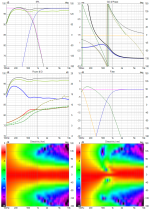
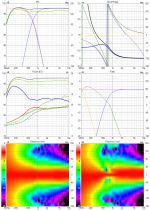
As seen, the smaller waveguide results smoother system DI because the directivity of waveguide doesn't match the woofers at crossover. c-c distance adjustment deals with the same thing mostly, smoothing DI by adjusting how much power is lost in vertical axis, while horizontal stays about the same.
So, it's actually better to have directivity mismatch at crossover to cancel less sound to get smoother DI?🙂 But, this of course shows in off-axis response, so choose which one is better per application 😉 whether it matters at all. Just something that gets touted around, while kimmosto for example has said this stuff multiple times I think.
Example, simulated 15" and 30cm waveguide, and the other image is the same waveguide but scaled bigger to 46cm make matching DI with the woofers. Overlays on the power / DI window are:
lime green is big waveguide, dark green the small waveguide, brownish green is the ideal 15".


As seen, the smaller waveguide results smoother system DI because the directivity of waveguide doesn't match the woofers at crossover. c-c distance adjustment deals with the same thing mostly, smoothing DI by adjusting how much power is lost in vertical axis, while horizontal stays about the same.
Last edited:
Sorry, edit time over and the post is incomplete. Forgot to mention the waveguides are freestanding and axisymmetric. Overlays in the power DI window are DI of the woofer and both waveguides alone demonstrating what's their match at crossover. Red line is system DI. Crossover is LR4 at 700Hz here. All other settings in simulation are same on the two images, except the waveguide (measurement data). The first image is smaller waveguide (30cm diameter) and the second is the bigger one(46cm dia).
I also failed to mention, that idea of matching directivity usually means ideal where horizontal system directivity is smooth without a jerk around crossover, like in case with ~beaming woofer and ~omni tweeter. Here I illustrated that there is some playroom within this ideal and rule of thumb. Both examples in my previous pist yield system with smooth horizontal directivity fulfilling the ideal, although directivity doesn't exactly match, literally.
I also failed to mention, that idea of matching directivity usually means ideal where horizontal system directivity is smooth without a jerk around crossover, like in case with ~beaming woofer and ~omni tweeter. Here I illustrated that there is some playroom within this ideal and rule of thumb. Both examples in my previous pist yield system with smooth horizontal directivity fulfilling the ideal, although directivity doesn't exactly match, literally.
Last edited:
Just finished this build up with @Bryan S. I designed these with a lot of inspiration and knowledge learned here from you guys so thanks!
Dual sealed Beyma 12br70s 25hz-500hz
Azura AH-340 with Faital HMF200 500hz-5khz
Azura AH-1100 with Faital HF10-AK 5khz-20khz
Triamped and using the Sublime k235 analog active crossover
Huge thanks to @Bryan S. for nailing the cabinets and @martin seddon for the horns
Dual sealed Beyma 12br70s 25hz-500hz
Azura AH-340 with Faital HMF200 500hz-5khz
Azura AH-1100 with Faital HF10-AK 5khz-20khz
Triamped and using the Sublime k235 analog active crossover
Huge thanks to @Bryan S. for nailing the cabinets and @martin seddon for the horns
Attachments
-
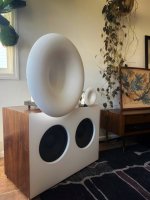 IMG_3136.jpeg584.1 KB · Views: 131
IMG_3136.jpeg584.1 KB · Views: 131 -
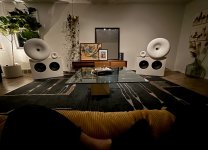 IMG_3122.jpeg613.6 KB · Views: 123
IMG_3122.jpeg613.6 KB · Views: 123 -
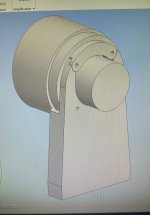 IMG_3171.jpeg655.1 KB · Views: 125
IMG_3171.jpeg655.1 KB · Views: 125 -
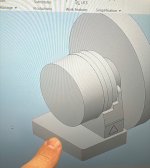 IMG_3172.jpeg414.2 KB · Views: 106
IMG_3172.jpeg414.2 KB · Views: 106 -
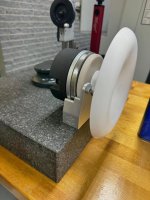 IMG_3176.jpeg163.1 KB · Views: 113
IMG_3176.jpeg163.1 KB · Views: 113 -
 IMG_3177.jpeg685.3 KB · Views: 107
IMG_3177.jpeg685.3 KB · Views: 107 -
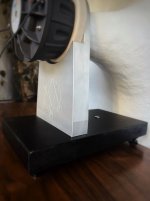 IMG_3130.jpeg323.6 KB · Views: 104
IMG_3130.jpeg323.6 KB · Views: 104 -
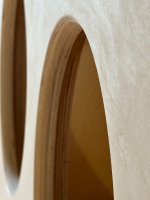 IMG_3161.jpeg476.6 KB · Views: 104
IMG_3161.jpeg476.6 KB · Views: 104 -
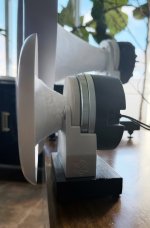 IMG_3133.jpeg455.2 KB · Views: 97
IMG_3133.jpeg455.2 KB · Views: 97 -
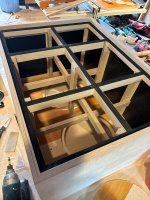 IMG_3164.jpeg893.6 KB · Views: 107
IMG_3164.jpeg893.6 KB · Views: 107 -
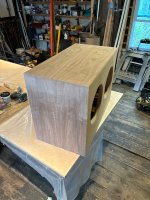 IMG_3165.jpeg991 KB · Views: 110
IMG_3165.jpeg991 KB · Views: 110 -
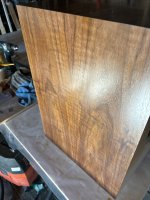 IMG_3167.jpeg875.2 KB · Views: 104
IMG_3167.jpeg875.2 KB · Views: 104 -
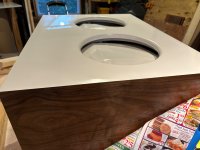 IMG_3169.jpeg642.9 KB · Views: 116
IMG_3169.jpeg642.9 KB · Views: 116
I too was surprised when discussing the availability of his speakers ("the tooling is all gone")-particularly the NS15 http://www.gedlee.com/Loudspeakers/NS15.aspx -Dr. Geddes replied
Regarding “perceptions”, you have things backwards from my thinking. A wide directivity will have many early reflections which tends to yield the “I am there” perception on live venue recordings. A very narrow directivity – like my speakers are designed for – will have very low early reflections and yields a very high “they are here” perception – especially on studio recordings. Live venue recordings have a mixed perception depending on the recording technique.
This is how I view the situation and what I have experienced.
This only applies when the speakers are toed in 45°, or in a large room, away from side walls.
Just finished this build up with @Bryan S. I designed these with a lot of inspiration and knowledge learned here from you guys so thanks!
Dual sealed Beyma 12br70s 25hz-500hz
Azura AH-340 with Faital HMF200 500hz-5khz
Azura AH-1100 with Faital HF10-AK 5khz-20khz
Triamped and using the Sublime k235 analog active crossover
Huge thanks to @Bryan S. for nailing the cabinets and @martin seddon for the horns
Have you tried the system as a 2-way, without the tweeter (horn) and the AH-340 in the middle?
The HMF200's breakup needs some taming (which can only be done by using passive components), but other than that, imaging and overall coherence may improve significantly.
Last edited:
- Home
- Loudspeakers
- Multi-Way
- Beyond the Ariel